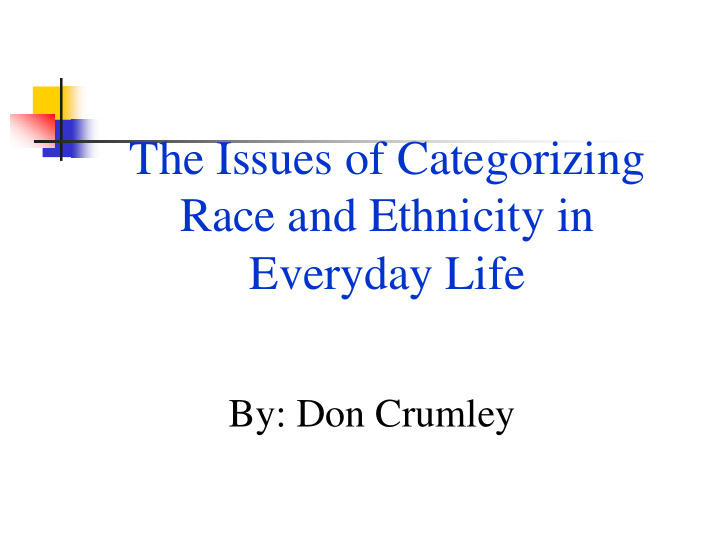



The Issues of Categorizing Race and Ethnicity in Everyday Life By: Don Crumley
Thesis Statement The ways official forms categorize people are not accurately representing everyone. There are complex differences between formal categories of race and ethnicity and the informal ways people self- identify.
Literature Review/Background “ There is a clear need for a more encompassing term that captures multiplicity at the ethnic group/cultural background level ” (Peter J Aspinall, 2009) “Not only did I find the emphasis on racial categorizations in the United States perplexing, but I felt that the selection offered was limited and problematic.” (Gisela Ernst, 2002)
Target Respondents SIUE students Limited survey to College of Arts and Science (CAS) {8,432 students} Professors in 7 classrooms facilitated, but I personally conducted 217 total respondents
Method- Mixed Type Survey Qualitative Quantitative 4 Free listing 4 Demographic questions questions
Do you feel that the selections of race or ethnicity used on surveys and forms properly identify you?
Demographic Analysis: Race This breakdown is remarkably similar to the racial/ethnic breakdown of CAS students (White 72.3%, Black+ Other 27.7%) Cannot test this variable because I would need to use the formal categories which I hypothesized are inadequate I would had to make race a closed ended question in order to test the relationship
Informal Responses to Race/Ethnicity Lumped into Formal Categories respon percent Statements: ses age rank White/Caucasian 207 64% 1 African Am./Black 56 17.4% 2 Hispanic/Latino 26 8% 3 Asian 17 5% 4 Native American 15 4.6% 5
Please list all of the terms for Race & Ethnicity that best describe you: Other (all responses below Examples of rank 10 combined) 118 “Other” White 111 Caucasian 86 Mixed 3 African-American 29 German 23 Anglo-Saxon 2 Black 22 Catholic 2 American 21 Irish 16 Brown 2 European (Northern, Human Being 1 Central, Eastern and Western) 14 Unknown 1 English/British 11
Demographic Analysis: City Size Relation between City Size and Satisfaction with Formal Categories 140 Number of Resondents 120 100 Not Prop ID 80 60 Prop ID 40 20 0 1-49,999 50,000- 100,000- 500,000- 1mil+ other 99,999 499,999 999,999 City Size
Reasons for Dissatisfaction among the 30% of Respondents who indicated that the formal categories were inaccurate Race and Ethnicity not good identifiers 26 18.80% Not many options 11 7.90% Mixed 9 6.50% It doesn ’ t matter 8 5.70% I am white 7 5.00% Prefer specifics 7 5.00% Unfair clumping of race and Ethnicity 7 5.00% Caucasian 6 4.30% Race/Ethnicity identified with nationality 6 4.30% More than just white 5 3.60%
Interpretation 118 “Other” – respondents that wrote something other than the normal categories Race and Nationality closely tied together Informal lumping was more in-depth than SIUE Fact Book Could city size be a factor regarding identity?
Thank You!! Dr. Cory Willmott-Anthropology (Mentor) Dr. Animato Cairo-Anthropology Dr. Tom Lavallee- Foreign Language Dr. Lisa Tellor-Kelley-English Dr. Francis Odemerho-Geography Dr. Mariana Solares-Foreign Language A special thanks to those who responded!
Bibliography: Aspinall, Peter J. 2009. ‘Mixed race’, ‘mixed origins’ or what? Generic terminology for the multiple racial/ethnic group population. Anthropology Today . 25(2):3-8. Ernst, Gisela. 2002. “Pais de Mis Suenos: Reflections on Ethnic Labels, Dichotomies, and Ritual Interaction.” In Distant Mirrors: America as a foreign culture, Philip R Devita and James D Armstrong, Pp. 102-108. New York: Wadsworth Publishing.
Recommend
More recommend